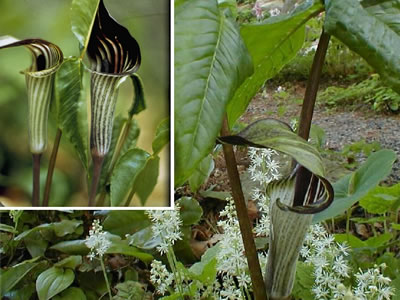The native Americans used arisaema triphyllum to treat colds and coughs. It was also used as a poultice made of the root to reduce pain and swelling caused by rheumatism.
Arisaema Triphyllum (Jack in the Pulpit) is a perennial plant in the genus Arisaema family. It is about 30 to 65 cm in height with three leaves and flowers.
The native Americans used the root of the Jack-in-the-Pulpit as food and medicine. Fresh roots of Jack in the Pulpit is poisonous. Ingesting the fresh corm can cause poisoning. The symptoms include a powerful burning sensation in the mouth, throat, short breathing, or irritation of the digestive system.
Native Americans used Arisaema Triphyllum as food and medicine
The native Americans only used aged or cooked roots as food. To neutralize the harmful acidity in the fresh corm, the corm was dried for several months, then peeled and ground into flour and made into bread as food. Scientists have found that the poisonous compound in arisaema triphyllum is the oxalic acid.
As a herbal medicine, the root of Jack in the Pulpit is acrid, diaphoretic, expectorant, irritant and stimulant. The native Americans used the aged corm of arisaema triphyllum as an expectorant to treat colds and coughs. It was also used as a purgative medicine. A poultice made of the root was used externally to treat rheumatism for reducing pain and swelling.
Rhizoma arisaematis (Tian Nan Xing) in traditional Chinese medicine
Arisaema Triphyllum is a relative to the Asian Arisaema species, such as Arisaema erubesccns(Wall.) Schott, Arisaema heterophyllum Blume, and Arisaema amurense Maxim. In traditional Chinese medicine (TCM), rhizoma arisaematis – the roots of the arisaema are named Tian Nan Xing, which is a strong warming and drying expectorant. It is often used to reduce dampness and phlegm, removing stubborn phlegm in the lungs, relieving cough, asthma, bronchitis and chest tightness caused by excess phlegm.
Rhizoma arisaematis (Tian Nan Xing) is also an antispasmodic in TCM. It is used to treat disorders caused by “wind phlegm”, such as dizziness, stroke, epilepsy, and hemiplegia. When using externally, it can treat skin ulcers, boils, and snake bites for reducing pain and swelling.
Raw rhizoma arisaematis is poisonous. in TCM, raw rhizoma arisaematis is processed to remove the harmful compounds. The method of making the prepared rhizoma arisaematis, according to the texts of TCM, is that: raw roots are soaked in water, changing water 2 to 3 times a day for several days, then add alum to the water for one more day until the the roots remain a slight burning sensation when tasted. Then boil the roots with ginger and alum. Dry in the sun, and cut the roots into slices when drying.
Please note, arisaema triphyllum and rhizoma arisaematis should be only used under a doctor’s supervision. Arisaema triphyllum and rhizoma arisaematis have strong warming and drying properties, they should not be used for dry cough, nor for a person with blood deficiency. Pregnant women should not use the herb.
References
- The Fox tribe used the seed of Jack-in-the-pulpit to mystically predict whether a patient would recover or die, Pizzo & Associates, Ltd.
- The Compendium of Materia Medica, Li Shizhen (1518-1593 AD)



